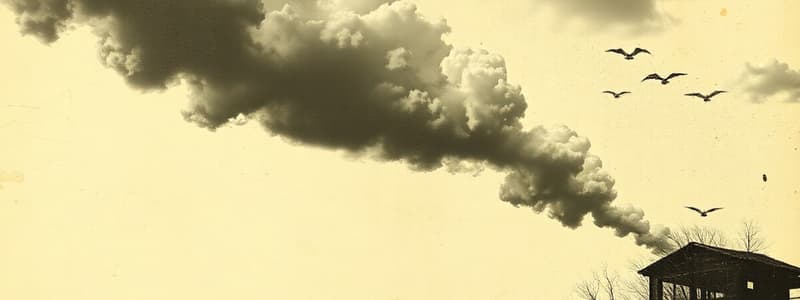Podcast
Questions and Answers
Considering the factors influencing atmospheric pressure, which scenario would most likely result in a decrease in surface pressure?
Considering the factors influencing atmospheric pressure, which scenario would most likely result in a decrease in surface pressure?
- A decrease in the volume of air due to adiabatic compression.
- A convergence of air masses leading to increased surface density.
- An increase in air temperature causing expansion and uplift. (correct)
- An increase in the density of air molecules due to cooling.
Given that the vertical pressure gradient force is generally balanced by gravity, why do we still experience winds?
Given that the vertical pressure gradient force is generally balanced by gravity, why do we still experience winds?
- Gravitational force only acts on stationary air masses.
- The balance is constantly disrupted by solar flares.
- The balance is disrupted by significant temperature inversions.
- Horizontal pressure gradients and the Coriolis effect induce air motion. (correct)
How would increasing the number of isobars on a weather map for a specific area impact the analysis of wind conditions?
How would increasing the number of isobars on a weather map for a specific area impact the analysis of wind conditions?
- Decrease accuracy, as closely spaced isobars negate pressure differences.
- No impact, as isobars only indicate temperature.
- Increase accuracy, by representing a weaker pressure gradient.
- Increase accuracy, as closely spaced isobars indicate a stronger pressure gradient. (correct)
Considering the influence of the Coriolis effect, how would the trajectory of an unguided projectile launched northward from the equator be affected?
Considering the influence of the Coriolis effect, how would the trajectory of an unguided projectile launched northward from the equator be affected?
At what geographical location would the geostrophic wind concept be least applicable, and why?
At what geographical location would the geostrophic wind concept be least applicable, and why?
If a high-pressure system is located over the Great Basin in the United States, what would you expect the wind patterns to be like?
If a high-pressure system is located over the Great Basin in the United States, what would you expect the wind patterns to be like?
How does the migration of pressure belts influence seasonal weather patterns in subtropical regions?
How does the migration of pressure belts influence seasonal weather patterns in subtropical regions?
Why do monsoon regions, such as Southeast Asia, experience significant shifts in wind direction and precipitation patterns throughout the year?
Why do monsoon regions, such as Southeast Asia, experience significant shifts in wind direction and precipitation patterns throughout the year?
Given the differential heating characteristics of land and sea, which scenario would most promote the development of a strong sea breeze?
Given the differential heating characteristics of land and sea, which scenario would most promote the development of a strong sea breeze?
During the night, a mountain slope cools, creating a katabatic wind. What conditions would intensify this effect?
During the night, a mountain slope cools, creating a katabatic wind. What conditions would intensify this effect?
If an air mass remains over a homogenous area like the Siberian Plains for an extended period during winter, how would its characteristics likely change?
If an air mass remains over a homogenous area like the Siberian Plains for an extended period during winter, how would its characteristics likely change?
What atmospheric conditions are most conducive to the formation of an occluded front?
What atmospheric conditions are most conducive to the formation of an occluded front?
How do extra-tropical cyclones differ from tropical cyclones in terms of their energy source and structure?
How do extra-tropical cyclones differ from tropical cyclones in terms of their energy source and structure?
Why are tropical cyclones more likely to dissipate upon making landfall?
Why are tropical cyclones more likely to dissipate upon making landfall?
How does the presence of upper-level divergence contribute to the intensification of a tropical cyclone?
How does the presence of upper-level divergence contribute to the intensification of a tropical cyclone?
Flashcards
Atmospheric Pressure
Atmospheric Pressure
The weight of a column of air above a unit area from sea level to the top of the atmosphere.
Isobars
Isobars
Lines on a weather map connecting places with equal atmospheric pressure.
Equatorial Low
Equatorial Low
Area near the equator characterized by low sea level pressure.
Subtropical Highs
Subtropical Highs
Signup and view all the flashcards
Subpolar Lows
Subpolar Lows
Signup and view all the flashcards
Coriolis Force
Coriolis Force
Signup and view all the flashcards
Cyclonic Circulation
Cyclonic Circulation
Signup and view all the flashcards
Anticyclonic Circulation
Anticyclonic Circulation
Signup and view all the flashcards
General Circulation
General Circulation
Signup and view all the flashcards
Hadley Cell
Hadley Cell
Signup and view all the flashcards
Sea Breeze
Sea Breeze
Signup and view all the flashcards
Air Mass
Air Mass
Signup and view all the flashcards
Front
Front
Signup and view all the flashcards
Extra Tropical Cyclones
Extra Tropical Cyclones
Signup and view all the flashcards
Tropical Cyclones
Tropical Cyclones
Signup and view all the flashcards
Study Notes
- Air expands when heated and compresses when cooled, which leads to atmospheric pressure variations.
- Air movement occurs from high to low pressure areas
- Horizontal motion of air defines Wind
Atmospheric Pressure
- It determines if air will rise or sink.
- Wind redistributes heat and moisture.
- Rising moist air cools, forms clouds, and causes precipitation.
- Atmospheric pressure results from the weight of an air column from sea level to the top of the atmosphere.
- It is measured in millibars (mb).
- Average atmospheric pressure at sea level is 1,013.2 mb.
- Air at the surface is denser due to gravity, leading to higher pressure.
- Pressure decreases with height.
- Pressure is measured using mercury or aneroid barometers.
- Pressure variations from place to place cause air motion or wind.
Vertical Variation of Pressure
- In the lower atmosphere, pressure decreases rapidly with height.
- The decrease is approximately 1 mb per 10 m increase in elevation.
- Vertical pressure gradient force is generally balanced by gravitational force.
Horizontal Distribution of Pressure
- Horizontal pressure distribution is analyzed using isobars that connect places with equal pressure at constant levels.
- Pressure is reduced to sea level to eliminate altitude effects.
- Low-pressure systems are enclosed by isobars with the lowest pressure in the center.
- High-pressure systems are enclosed by isobars with the highest pressure in the center.
World Distribution of Sea Level Pressure
- Near the equator, there is an equatorial low-pressure area.
- Subtropical highs are found along 30° N and 30° S.
- Subpolar lows are located around 60° N and 60° S.
- Polar highs are near the poles.
Factors Affecting Wind
- Wind is air in motion, moving from high to low pressure areas.
- Friction at the surface, Earth's rotation, and gravitational force affect wind.
- Coriolis force is exerted by the earth's rotation
- Horizontal winds respond to pressure gradient, friction, and Coriolis forces.
Pressure Gradient Force
- Differences in atmospheric pressure create this force.
- The pressure gradient is strong when isobars are close and weak when they are far apart.
Frictional Force
- Frictional force affects wind speed
- The influence of Frictional force is greatest at the surface and extends up to 1-3 km.
- Friction is minimal over the sea surface.
Coriolis Force
- The rotation of the Earth affects wind direction with Coriolis Force
- It deflects wind to the right in the Northern Hemisphere and to the left in the Southern Hemisphere.
- Deflection is proportional to wind velocity and latitude.
- Coriolis Force is maximum at the poles and absent at the equator.
- It acts perpendicular to the pressure gradient force.
Pressure and Wind
- Wind velocity and direction result from wind-generating forces.
- Upper atmosphere winds are controlled by pressure gradient and Coriolis force.
- Geostrophic winds blow parallel to isobars when pressure gradient force is balanced by the Coriolis force.
- Wind circulation around a low is cyclonic and around a high is anticyclonic.
General Circulation of the Atmosphere
- Planetary winds depend on latitudinal heating, pressure belts, migration of belts, distribution of continents and oceans, and Earth's rotation.
- General circulation influences ocean water circulation.
General Atmospheric Circulation and its Effects on Oceans
- Warming and cooling in the Pacific Ocean can trigger phenomena such as El Nino.
- El Nino involves warm water moving towards the South American coast.
- Southern Oscillation involves pressure changes in the Pacific.
- ENSO (El Nino-Southern Oscillation) can cause variations in weather patterns worldwide.
Seasonal Wind
- Wind circulation changes with seasons due to shifting heating, pressure, and wind belts.
Local Winds
- Common local and regional winds occur because of heating and cooling differences.
Land and Sea Breezes
- During the day, land heats faster than the sea, causing air to rise and creating a sea breeze (wind from sea to land).
- At night, the land cools faster, reversing the process and creating a land breeze (wind from land to sea).
Mountain and Valley Winds
- During the day, slopes heat up and air moves upslope, creating a valley breeze.
- At night, slopes cool and dense air descends into the valley as a mountain wind.
- Katabatic winds are cool air from high plateaus draining into valleys.
Air Masses
- Air that remains over a homogeneous area for a long time acquires the area's characteristics.
- An air mass is a large body of air with little horizontal variation in temperature and moisture.
- Source regions are the homogeneous surfaces where air masses form.
- Air masses are classified based on source regions: Maritime tropical (mT), Continental tropical (cT), Maritime polar (mP), Continental polar (cP), and Continental arctic (cA).
- Tropical air masses are warm and polar air masses are cold.
Fronts
- A front is a boundary zone between two different air masses.
- Frontogenesis is the process of front formation.
- Types of fronts: Cold, Warm, Stationary, and Occluded.
- Stationary Front: The front remains stationary
- Cold Front: Cold air moves towards a warm air mass.
- Warm Front: Warm air moves towards a cold air mass.
- Occluded Front: An air mass is fully lifted above the land surface.
Extra Tropical Cyclones
- Extra tropical cyclones form along the polar front.
- Initially, the front is stationary
- Warm air moves northwards, and cold air moves southwards, creating cyclonic circulation.
- The cyclone has a warm front and a cold front.
- Warm air glides over cold air causing cloud formation and precipitation.
- The cold front approaches and pushes warm air up, forming cumulus clouds.
- Occluded Front: Cold front overtakes the warm front and lifts the warm air, and cyclone dissipates.
Tropical Cyclones
- Tropical cyclones originate over oceans in tropical areas, leading to large-scale destruction through strong winds, heavy rainfall, and storm surges.
- Hurricanes (Atlantic), Typhoons (Western Pacific, South China Sea), Willy-willies (Western Australia), and Cyclones (Indian Ocean).
- Conditions favoring development: warm sea surface (over 27°C), Coriolis force, small variations in vertical wind speed, a pre-existing low-pressure area, etc.
- Intensification comes from condensation in cumulonimbus clouds.
- The storm cuts off moisture supply and dissipates, after reaching land.
- The landfall is the point where the cyclone crosses the coast.
- The place where a tropical cyclone crosses the coast is called the landfall of the cyclone.
- Eye: calm with subsiding air
- Eyewall: Strong spiralling ascent of air, with maximum wind velocity and torrential rain.
- Rain Bands: Trains of cumulus and cumulonimbus clouds that may drift into the outer region.
Thunderstorms
- Thunderstorms are caused by intense convection on moist hot days.
- A thunderstorm has thunder and lightning
- Hailstorms can occur, if clouds have sub-zero temperature
- The updraft of warm air causes clouds to grow.
- Downdraft brings rain and cool air.
Tornadoes
- In severe thunderstorms, spiralling wind descends with low pressure, causing destruction.
- Tornadoes occur in middle latitudes
- Water spouts are tornadoes over the sea.
Studying That Suits You
Use AI to generate personalized quizzes and flashcards to suit your learning preferences.




